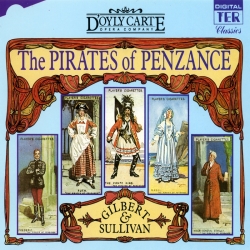The Pirates of Penzance (Complete Recording of the Score)
The D'Oyly Carte Opera
 |
DIGITAL
RECORDING
DDD
CD1 44'55''
CD2 40'29''
Download Links |
|
> amazon.com > iTunes > Prime Music > Spotify > YouTube Music |
You may also like |
|||||||||||||||
|
Gilbert & Sullivans
THE PIRATES OF PENZANCE
or
THE SLAVE OF DUTY
Chorus and Orchestra of
THE D'OYLY CARTE OPERA
Conducted by
John Pryce Jones
Marilyn Hill Smith
Malcom Rivers, Eric Roberts
Philip Creasy, Susan Gorton
Simon Masterson Smith, Pauline Birchall
Patricia Cameron, Gareth Jones
+++++++++++++++++++++++++++++
On a building in East Twentieth Street, New York, is to be found the following inscription: “On this site Sir Arthur Sullivan composed ‘The Pirates of Penzance’ in 1879.” How this most British of operettas came not only to be completed but also produced in the United States of America is a fascinating part of the history of the Gilbert and Sullivan partnership.
With their production of H.M.S. PINAFORE in 1878 William Schwenk Gilbert (1836-1911) and Arthur Sullivan (1842-1900) achieved a popular success which far surpassed that of their previous collaborations and confirmed their place amongst the front rank of creators of operetta. “Pinafore Mania” - to quote a contemporary headline - swept not only Britain but also the United States of America. Within a few months of its success in London, numerous companies were presenting their version of the operetta on the other side of the Atlantic, but without payment of any kind by way of royalties to its creators - such was the inadequacy of the international copyright laws. The injustice rankled with both Gilbert and Sullivan, as well as with their guiding impresario Richard D’Oyly Carte. Having visited America to assess the situation, Carte concluded that the best way of dealing with unauthorized productions there was to take the authentic article across the Atlantic to show up the inferior and ludicrously modified ‘pirate’ versions for what they were. The plan succeeded brilliantly. Gilbert and Sullivan’s production of H.M.S. PINAFORE took New York by storm.
Anxious that the next operetta should not be so easily ‘pirated’, Gilbert, Sullivan and Carte decided to produce the new work whilst in the United States, thereby securing the American copyright and at the same time stealing another march on their rivals. Thus, on New Year’s Eve, 1879, THE PIRATES OF PENZANCE was received with enormous enthusiasm by a glittering first night audience at New York’s Fifth Avenue Theatre.
That performance was not, however, the very first. A few hours earlier, in a tiny theatre on the Devonshire coast, the world premiere of THE PIRATES OF PENZANCE has passed almost unnoticed. Mounted in deliberate obscurity and timed to coincide with the first performance in New York, the sole object of that bizarre performance at the Royal Bijou Theatre, Paignton, on December 29, 1879, was to secure the British copyright of the new work. The cast (members of one of D’Oyly Carte’s touring companies which was playing PINAFORE in the area at the time) had but one rehearsal to work up some semblance of a performance. Understandably they took their scripts and music on stage, reading from them a version of the operetta which differed considerably from what was to be played only a few hours later in New York. The Paignton libretto was, seemingly only an early draft and the last batch of music shipped on December 17 could not have taken into account numerous late additions to and deletions from the score.
London had to wait until the following April 3 for its first performance. With an appetite whetted by news of the American production, the audience packed the Opera Comique Theatre and confirmed that Gilbert and Sullivan had indeed created a worthy successor to H.M.S. PINAFORE. THE PIRATES OF PENZANCE ran for a year in London - a total of 363 performances - establishing a popularity which today, well over on hundred years later, shows no sign of diminishing.
Many of Gilbert’s libretti have their germ in the author’s earlier work. In the case of THE PIRATES OF PENZANCE it lies in a one act musical piece, OUR ISLAND HOME, produced by German Reed at the Gallery of Illustration in 1870. This included not only a Pirate Chief, Captain Bang, but also, amongst other similarities, a nurse who mistakenly apprentices her charge to a pirate instead of a pilot. Also, in the following year (1871) Gilbert had translated the libretto of Offenbach’s LES BRIGANDS which had certain similarities with his own later pirate libretto. Indeed, during the drafting of the operetta Gilbert built his plot around a band of brigands and worked for some time with the provisional title of THE ROBBERS. The pirate element was an afterthought, perhaps prompted by the success of his previous libretto, with its maritime connection, or because literary piracy was very much on his mind at the time.
In addition to its origins within Gilbert’s own work, THE PIRATES OF PENZANCE also draws upon an enormous corpus of melodramatic plays and operas involving outlawed bands of robbers or pirates, contriving some amusing theatrical burlesque at their expense. The burlesquing of melodramatic grand opera is, indeed, brilliantly handled, as in Act II where the exit of the policemen in pursuit of the pirates evokes so many protracted operatic departures. To find only vulgarity in “Come, friends, who plough the sea” - as Thomas Dunhill did - is to miss its point as a parody of the ‘Anvil Chorus’ from Verdi’s IL TROVATORE. “Poor wand’ring one” is an intrinsically attractive soprano showpiece, but it is also, as Sullivan intended, a burlesque of the operatic waltz song a la Gounod, and a very clever one at that.
Before leaving England Gilbert had produced a working libretto of the operetta and Sullivan had sketched out a considerable amount of music for Act I. Nonetheless, when the collaboration left for America a good deal of work had yet to be done. With the production of PINAFORE to deal with as well, the schedule promised to be a taxing one. In the event, it proved to be exceptionally gruelling, especially for Sullivan who, having inadvertently left his Act I sketches in London, spent much valuable time duplicating earlier efforts. We do not know exactly how accurate was his recall, but, according to Gilbert, one setting the composer could not remember was the entry chorus for the Major-General Stanley’s daughters in Act I. For this reason, the librettist related many years after the event, a chorus from the collaborators’ first operetta, THESPIS, (most of the music from which is now lost), was pressed into service. Examination of Sullivan’s autograph full score certainly reveals the opening choral section of “Climbing over rocky mountain” to be an adaptation of the earlier material, for the pages in question have been extracted from copyist’s score of THESPIS and altered; that the remainder of the number appears in its familiar form in Sullivan’s hand, however, rather suggests some reworking beyond the level of minor alterations was carried out. Weighing up other evidence, too, tends to cast doubts on Gilbert’s tale and favours the view that the re-use of the THESPIS chorus had been planned before the departure for America.
The music sent by Sullivan for the Paignton performance would have been no more than a skeletal vocal score to be performed with piano accompaniment. The enormous task of orchestration was not begun until after the final shipment was despatched. It was completed, but for the Overture, within ten days, alongside a hectic schedule of rehearsals. The Overture itself was begun and finished in the early hours of the day of the premiere. Returning from the final dress rehearsal, Sullivan and Alfred Cellier, the company’s musical director and a long standing friend of the composer, set to work on its composition - most of the autograph manuscript is in Cellier’s hand. Gilbert and the composer Frederic Clay, whose collaboration PRINCESS TOTO had also been produced in New York by Carte - joined them later and assisted with copying of some of the parts. A short late morning rehearsal of the rapidly written Overture completed musical preparations for the opening night.
As always during the rehearsal period for a new operetta, changes were made to the work, and the evidence of such modification is more that usually abundant in Sullivan’s autograph full score of THE PIRATES OF PENZANCE - especially in Act II. One lengthy passage cut before orchestration - and therefore before the New York premiere - was a hymn-like apostrophe to Queen Victoria - its vocal lines survive complete in the manuscript - which received its sole public performance at Paignton. The most important change made by Gilbert and Sullivan after the New York premiere concerned the end of Act II Finale. As first played this involved a musical reprise of the Major-General’s patter song to a different text. This was replaced for the London opening, if not before, by a reprise of the musically more eloquent “Poor wand’ring one”. If other changes were made for London it is not clear what they were. Sullivan recorded his intention to do some work on the Overture; but examination of the autograph manuscript suggests that the “Come, friends, who plough the sea” coda is the only section he might have changed.
Over its many years in the D’Oyly Carte repertoire the music and libretto of THE PIRATES OF PENZANCE underwent various minor changes. Examinations of authentic sources permits an informed reassessment of the text and some of the restoration work will be evident in listening to the present recording. The most striking deviation from modern published scores occurs in the Act II Finale, into which Gilbert and Sullivan originally wove an amusing quotation from PINAFORE. This reference to the “What never?/Well, hardly ever” exchange - an ungainly syllabic setting deliberately mocking the common mangling of the catch-phrase by would-be humourists - was apparently deleted by Gilbert in 1902 (after Sullivan’s death). The recording gives us a chance to hear the passage exactly as Sullivan left it.
- Overture
- Pour, Oh Pour, The Pirate Sherry
- When Fred'ric Was A Little Lad
- Oh, Better Far To Live and Die
- Oh! False One You Have Deceiv'd Me
- Climbing Over Rocky Mountain
- Stop, Ladies Pray!
- Oh! Is There Not One Maiden Breast
- Poor Wand'ring One!
- What Ought We To Do?
- How Beautifully Blue The Sky
- Stay, We Must Not Lose Our Senses
- Hold, Monsters!
- I Am The Very Model
- Finale Act One
- Oh! Dry The Glist'ning Tear
- Then, Frederic, Let Your Escort Lion-Hearted
- When The Foe-Man Bares His Steel
- Now For The Pirates Lair!
- When You Had Left Our Pirates Fold
- Away, Away, My Hearts On Fire
- All Is Prepar'd
- Stay Frederic, Stay!
- No, I'll Be Brave!
- When A Felon's Not Engaged In His Employment
- A Rollicking Band of Pirates We
- With Cat-Like Tread
- Hush, Hush! Not a Word
- Sighing Softly To The River
- Now What Is This? / Finale Act Two








